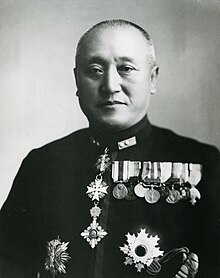Nobutake Kondō
Nobutake Kondō | |
|---|---|
 | |
| Native name | 近藤 信竹 |
| Born | 25 September 1886 Osaka, Kansai, Empire of Japan |
| Died | 19 February 1953 (aged 66)[1] Tokyo, Japan |
| Allegiance | |
| Service/ | |
| Years of service | 1907–1945 |
| Rank | |
| Commands held | Kako, Kongō, Naval Operations Bureau, 5th Fleet, Vice-chief of Navy General Staff, 2nd Fleet, Naval Councillor, China Area Fleet[2] |
| Battles/wars | |
| Awards | Order of the Rising Sun (2nd class) Order of the Golden Kite (1st class and 3rd class) Order of the Sacred Treasure (3rd class) |
| Other work | Supreme War Council |
Nobutake Kondō (近藤 信竹, Kondō Nobutake, 25 September 1886 – 19 February 1953) was an admiral in the Imperial Japanese Navy during World War II. As commander of IJN 2nd Fleet, the Navy's principal detached force for independent operations, Kondō was regarded as second in importance only to Admiral Isoroku Yamamoto.
Biography
Early life and career
Kondō was a native of
After the end of the war, Kondō attended the Naval Staff College, and was promoted to lieutenant commander on 1 December 1919.
From 1920 to 1923, Kondō was stationed in
Kondō was promoted to
World War II
After the start of the
At the time of the
In the second night action of the Naval Battle of Guadalcanal on 14/15 November 1942, Kondō personally led the battleship Kirishima along with cruisers Atago, Nagara, Sendai, and Takao, in what was to have been a decisive attack to eliminate the threat from Henderson Field through a massive nocturnal shelling. Instead, Kondō was confronted by an American task force with battleships USS Washington and USS South Dakota, and was defeated, losing Kirishima. This defeat marked a turning point of the entire Guadalcanal campaign.[3]
Kondō was apparently tainted by the Guadalcanal failures, and was soon removed from seagoing commands, or indeed any positions of real authority. Yamamoto's demotion of Kondō was nonetheless less harsh than that of his predecessor, Hiroaki Abe, due to Imperial Navy culture and politics. Kondō, who also held the position of second in command of the Combined Fleet, was a member of the upper staff and "battleship clique" of the Imperial Navy while Abe was a career destroyer specialist. Kondō was not reprimanded or reassigned but instead was left in command of one of the large ship fleets based at Truk.[4]
Kondō was appointed Deputy Commander of the
Notes
- ^ Nishida, Hiroshi. "Imperial Japanese Navy". Retrieved 17 August 2022.
- ^ "Kondo Nobutake".
- ^ a b c d L, Klemen (1999–2000). "Vice-Admiral Nobutake Kondo". Forgotten Campaign: The Dutch East Indies Campaign 1941–1942.
- ^ Hara, Japanese Destroyer Captain, 157, 171.
References
- Nishida, Hiroshi (2002). "Imperial Japanese Navy". Retrieved 17 August 2022.
- L, Klemen (1999–2000). "Forgotten Campaign: The Dutch East Indies Campaign 1941-1942".
Further reading
- D'Albas, Andrieu (1965). Death of a Navy: Japanese Naval Action in World War II. Devin-Adair Pub. ISBN 0-8159-5302-X.
- Dull, Paul S. (1978). A Battle History of the Imperial Japanese Navy, 1941–1945. Naval Institute Press. ISBN 0-87021-097-1.
- Dupuy, Trevor N. (1992). Encyclopedia of Military Biography. I B Tauris & Co Ltd. ISBN 1-85043-569-3.
- Parrish, Thomas (1978). The Simon and Schuster Encyclopedia of World War II. New York: Simon & Schuster. ISBN 0-671-24277-6.
- Van Der Vat, Dan (1978). Pacific Campaign: The U.S.–Japanese Naval War 1941–1945. New York: Simon & Schuster. ISBN 0-671-79217-2.
